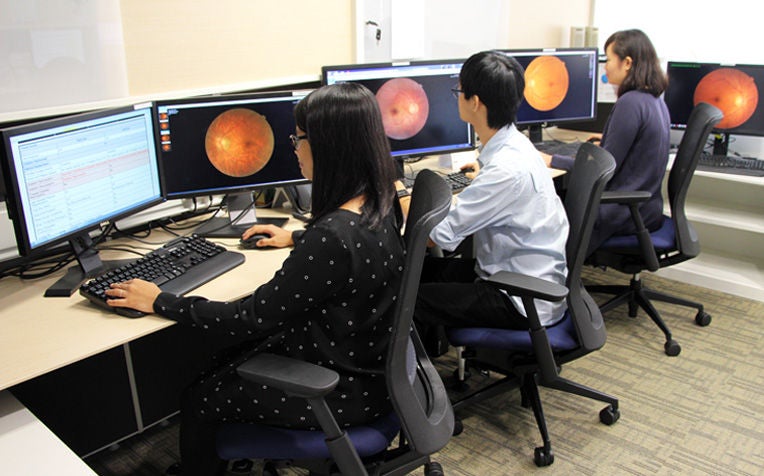
Trained ophthalmic grading technicians performing assessment for diabetic retinopathy and other ocular diseases.
Diabetic retinopathy (DR) is a leading cause of vision loss in Asia. Singapore has one of the highest prevalence rates of diabetes mellitus (DM) worldwide, with 10% of Singapore adults between the ages of 18 and 69 having diabetes. Of these, approximately 30% have DR and 10% of these patients have vision-threatening DR.
Traditional DRP Model
In the 1980s, the MOH Diabetic Retinal Photography (DRP) programme was initiated to screen for DR. This involves the capture of retinal photographs from patients with diabetes who visit the polyclinics. These photographs are then assessed by polyclinic doctors who have undergone basic training on DR assessment. If DR was present, the patient makes a 2nd visit to the polyclinics, and is subsequently referred to tertiary eye care for management.
There are limitations to the traditional DRP model i.e.
Delay in diagnosis and referral of patients with DR
Inconsistencies in the grading outcomes with no standardized protocol
Cost-ineffective as polyclinic doctors were made to assess DR when this can be performed by trained non physician readers i.e. Optometrists and Ophthalmic Technicians.
About Singapore Integrated Diabetic Retinopathy Programme (SiDRP)
The Singapore National Eye Centre (SNEC) and Singapore Eye Research Institute (SERI) established the Singapore Integrated Diabetic Retinopathy Programme (SiDRP), which is a major improvement from the old DRP model with the establishment of a comprehensive screening model based on “real time” assessment of DR from photographs by a centralized team of trained and accredited non-physician readers, supported by a robust tele-ophthalmology IT infrastructure. Patients will have photographs that are graded within 1 business day and if necessary, are referred to tertiary eye care, based on a recommendation made by the non-physician readers according to a standardized protocol.
All DRP screenings are uploaded onto a common IT platform and are read by a team of trained and accredited non-physician readers. The new platform is equipped with an excellent workload management system for both centres in SNEC and the National Healthcare Group Eye Institute (NHGEI), with an online audit and training system which is the “first-of-its-kind” in the world.
SiDRP is one of the first successful joint cluster programmes, funded by Health Services Development Programme (HSDP) that has been deployed in all polyclinics island wide. SNEC started in July 2010 by piloting in Outram Polyclinic and NHGEI commenced in April 2012 in Hougang Polyclinic. At the end of FY2019, SiDRP has screened more than 600,000 patients in total. 99.8% of the reports were generated within 1 business day.
The SiDRP system is a major paradigm shift in the management of DR in MOH, and will reflect investment in translational research with direct benefit to patients, improved productivity and cost savings to the healthcare system. The SiDRP model is an effective DR screening programme which saves costs and ophthalmologist manpower compared to the traditional model of using FP doctors to read images. Hai et al (2016) showed that cost-savings attributed by using an SiDRP model, is estimated to be $144 per person. Extrapolating to the entire polyclinic diabetic population would save S$29.4 million over a lifetime horizon.
Future of SiDRP
SiDRP is the most successful comprehensive diabetic screening programme in Asia. SiDRP will be used as a reference model for our neighbouring countries to follow and emulate. We will continue to use the vast, rich data collected in SiDRP to further expand our research and outreach to the patients.
In the future, we intend to use innovative, cutting-edge technology to reduce number of human reads. With the number of diabetics set to increase globally, the number of eye screening cases is also expected to increase. Training readers requires significant resources and time, and they are a limited in number. Hence, SiDRP has implemented a software called Singapore Eye Lesion Analyzer PLUS (SELENA+) to help reduce the number of manual reads by human readers.
SELENA+ is a deep learning system powered by Artificial Intelligence, co-developed by SNEC / SERI and our technical partners in National University of Singapore, School of Computing. A validation study was conducted and published in JAMA on SELENA’s diagnostic performance for diabetic retinopathy, glaucoma suspect features and age-related macular degeneration5. Approximately 50% of the SiDRP cases assessed do not have referable DR (Moderate NPDR and above), and do not need a referral to SOC for further eye examination and management. These cases can be reported automatically by SELENA+ and the human readers will focus on those that are detected as abnormal or questionable.
The implementation of SELENA+ into SIDRP is still in the pilot phase, with validation test undergoing to measure the performance and accuracy of SELENA+.
Ref: L20
Check out other articles on diabetic retinopathy and diabetes management:
Diabetic Retinopathy: Causes, Symptoms, Treatment
How Diabetes Can Cause Other Complications

















 Get it on Google Play
Get it on Google Play